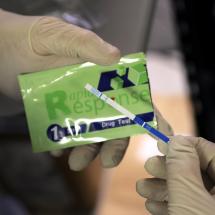Reducing Harm

Fentanyl test strip.Travis Dove for The New York Times
Harm Reduction
Drug Consumption Rooms
Overdose Prevention
Safe Injection Sites
Drug War
Drug Policy Reform
Overview
Originally Published: 05/04/2023
Post Date: 05/04/2023
by German Lopez - The New York Times
Summary/Abstract
Fentanyl Testing Strips - Bipartisan support now exists for a once-radical approach to drugs.
Content
Reducing harm
For decades, the U.S. focused on trying to scare people away from drugs, instituting tough criminal penalties and emphasizing law enforcement over addiction treatment.
But a major change is underway.
The old approach failed to prevent an overdose crisis that now kills more than 100,000 Americans a year. Policymakers have awakened to the urgency of the problem and shifted resources, namely funding, toward treatment. While criminal penalties for drugs remain, many states, led both by Democrats and Republicans, have lessened them. Lawmakers now often discuss drugs as a problem of public health, not just criminal justice.
Some lawmakers have even embraced a once-radical strategy called harm reduction. The approach focuses on mitigating the potential dangers of drugs, not necessarily encouraging users to abstain.
Republicans, whose party historically opposed harm reduction, are among those backing some tenets of it. The Republican-controlled Texas House of Representatives voted last month for a bill that would decriminalize test strips to check drugs for fentanyl, the potent opioid that is often mixed into heroin, pills and other drugs. Republican strongholds, including Kentucky, Utah and Mississippi, recently decriminalized the test strips.
“My hope is that every person struggling with addiction has access to a quality recovery program and has the opportunity to gain and maintain long-term sobriety,” Representative Tom Oliverson, the Texas Republican who sponsored his state’s bill, told me. “But if they die instantly from a drug they didn’t even know they were taking, I can’t fix that. Nobody can.”
The country has undergone a “decided shift” in favor of harm reduction, said Regina LaBelle, who led the White House’s Office of National Drug Control Policy under President Biden. In 2015, Congress lifted a funding ban for needle exchanges, where clean syringes are distributed to keep people from reusing or sharing potentially infected devices. And in March, the F.D.A. for the first time made naloxone, a medication that reverses opioid overdoses, available over the counter.
Mitigating risk
The modern version of harm reduction originated in the 1980s, when a widespread drug problem and the AIDS crisis motivated activists to pursue something other than criminalization.
They helped create needle exchanges in hopes of stopping the spread of H.I.V. through dirty syringes. Critics argued that needle exchanges would encourage drug use and could lead to more overdose deaths by removing a deterrent to using drugs.
Real-world evidence disproves those claims. Needle exchanges have been shown to reduce infections, according to the C.D.C. In fact, needle exchange programs can reduce overdoses and drug use over time, by acting as hubs that educate people on safe practices and connect them to addiction treatment.
Much of this evidence has existed for decades. But it was not until recently that many more policymakers embraced harm reduction approaches.
A softer touch
What changed? Three things, experts say.
First, lawmakers grew desperate to reduce overdose deaths, which have climbed for decades and surpassed 100,000 annually for the first time in 2021. Old ideas, like harsh criminal penalties, were clearly insufficient. So lawmakers turned to alternatives they once dismissed, seeking any kind of solution.
Second, the overdose crisis is now so widespread that many more people, including members of Congress, know someone hurt by it. “Every single member of the House and Senate has grieving constituents coming in, having buried kids or brothers or sisters or moms or dads,” Keith Humphreys, a Stanford University drug policy expert, said. “That creates incentives, both emotional and political, to try things that otherwise would be unacceptable.”
And third is the role of race and class. Previous drug crises disproportionately hurt marginalized populations — such as Black people during the 1980s crack epidemic and poor white people during the 1990s-2000s meth epidemic. White, wealthy people had little exposure to these problems. Stereotypes about drug use flourished. A punitive approach, aimed at keeping drugs away from as-yet-unaffected communities, took hold.
The current overdose crisis has more directly hit white people of all classes, including lawmakers. As uncomfortable as it may be that policymakers can be more apt to act — and do so compassionately — when a problem personally affects them, it’s often true.
Limits in support
Harm reduction is still far from gaining universal acceptance. Last year, Senate Republicans criticized the potential inclusion of crack pipes in safe smoking kits from federally funded programs. Some conservative states, like West Virginia, have restricted or blocked needle exchange programs. Many lawmakers of both parties reject more controversial ideas, like supervised injection sites. In Texas, the House’s fentanyl test strip bill is mired in a Senate committee, despite Gov. Greg Abbott voicing support for the idea.
Still, there is notable movement, however uneven. Three years ago, fentanyl test strips were outlawed in 33 states. Today, they are legal or soon will be in at least 37.





